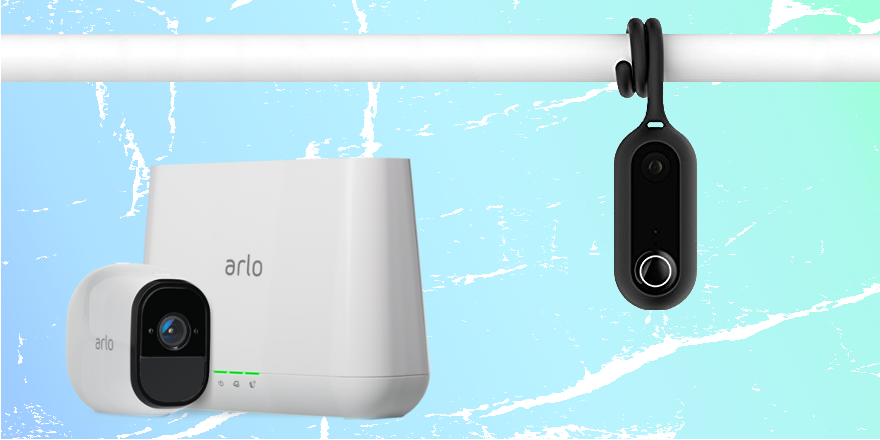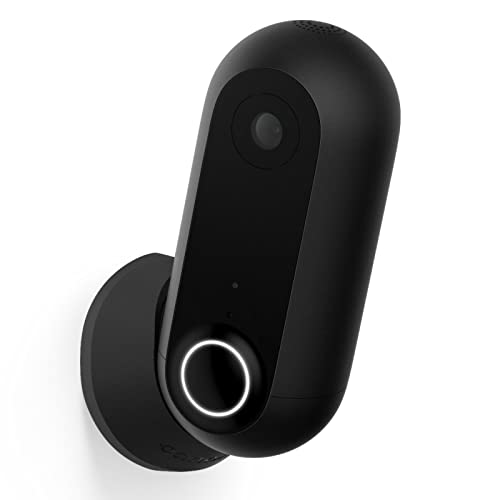Choosing between two smart home security devices is difficult. With so many features, and how interconnected and high tech our homes have become, there are more options than ever before when it comes to keeping your home safe and secure. And it’s sometimes hard to get a straight, no-nonsense account of what exactly a device has to offer.
So what we’ll do is try to give you a detailed comparison of the Arlo Pro and Canary Flex to help make navigating the smart security scene a little bit easier.
Arlo Pro vs. Canary Flex — Differences
-
Difference #1: Resolution and Field-of-view – Perhaps one of the most important considerations to take into account is a camera’s resolution and field of view. If you’re not able to capture the action and actually make sense of the footage, why get a smart surveillance system?
When it comes to resolution and FOV, there are pros and cons to both the Arlo Pro and the Canary Flex. The Arlo has a wider field of view at 130 degrees compared to the Canary’s 116 degrees, but the Canary has a resolution of 1080p — much better than the Arlo’s 720p.
Which camera is better will depend on your individual needs. If you’re relying on a camera to cover a wider area, the Arlo Pro will probably serve you better. If, on the other hand, you’d really like a higher resolution, the Canary Flex has the advantage.
-
Difference #2: Motion recording – Perhaps one of the most crucial aspects to discuss when it comes to home security is how the device knows when to start recording. Both the Arlo Pro and the Canary Flex utilize motion sensors in order to know when to activate, but there are some key differences between the way the two models work.
The Arlo Pro records for 10 seconds from the moment it detects motion, but you can set it to record for up to 300 seconds (5 minutes) in your custom settings.
The Canary Flex also records for 10 seconds, but if you purchase a Canary Membership ($9.99/month or $99/annually), it can record until the motion ends. Some other additional Canary Membership benefits include custom setting modes, two-way push-to-talk functionality, and Activity Zone Masking which improves intelligence notifications, as well as incident support services in case the unthinkable were to happen.
-
Difference #3: Storage – How your device stores content is worth noting, as it’s important to be able to access footage when needed.
The Arlo Pro features 7 day cloud storage by default, but also offers support for local storage. Simply connect a USB device to the base station and use it as a second location to store your recordings locally. This is a great option if you don’t trust your internet reliability or want to store more footage than recordings from the previous 7 days. Visit the Arlo support forum to get a little bit deeper into how Arlo local storage works.
The Canary Flex does not support hard storage, and only includes 24 hours of cloud storage by default. A Canary membership allows for 30 days of cloud storage, which should be more than enough for the vast majority of users.
-
Difference #4: Remote viewing – Most smart security systems allow users to view footage while away from home, which adds great peace of mind. Knowing that you can always check in on your house is a wonderful feature, and easy access to this footage is a big plus.
Both the Arlo Pro and the Canary Flex offer live views from their mobile apps. Additionally, the Arlo Pro provides footage access via the web. While not a major dealbreaker, the extra functionality of the Arlo Pro for remote viewing access is a nice plus.
-
Difference #5: Base station – Some smart home security systems require a base to function properly, while other cameras will work right out of the box.
The Arlo Pro requires a base, but the device is included with any Arlo Pro Starter Kit.
The Canary Flex, on the other hand, does not require any sort of base. Cameras connect directly to the app, cutting out the middleman and offering more convenience and ease of use.
-
Difference #6: Siren – Even though having a base station for Arlo cameras might not seem very convenient, the security benefits behind it are a total gamechanger. The Arlo Pro Base Station features a built-in, 100+ decibel siren. You can control the siren remotely from the Arlo app, or set it to be triggered by motion or audio. So, you get a good chance to scare off the burglars and save your belongings.
Canary Flex doesn’t have these feature, but from what we know their team is looking very closely at this matter and trying to find ways to implement it.
-
Difference #7: Power – Like any electronic device, your smart home security cameras require power to function. And with cameras, it’s important to know how they’re powered, because battery life can be a pain and visibility can increase with hardwired systems.
Both the Arlo Pro and the Canary Flex come with a rechargeable battery, and each can also be hardwired for less ongoing maintenance.
The rechargeable battery of the Canary Flex lasts around 2 months on a full charge, while the Arlo Pro lasts around 6 months. The Arlo has the added perk in support for a solar power charger, further enhancing the ability to “set it and forget it”.
-
Difference #8: Push-to-talk – Both devices feature some sort of push-to-talk functionality, but differ in implementation. The Arlo Pro features push-to-talk by default, allowing you to answer the door while away from home, check on who’s in the room, and even tell your pets to get off the couch!
The Canary Flex also has a push-to-talk feature, but it’s only available with the optional Canary membership.
-
Difference #9: Color – While perhaps not important to the device’s functionality, it’s always nice when your security cameras match your home decor. The Arlo Pro is only available in white, but offers several additional colors in the form of skins (purchased separately). These skins can help your cameras blend in seamlessly with your environment, a benefit that’s both aesthetic and utilitarian.
The Canary Flex is only available in black or white and doesn’t offer support for any additional skins.
-
Difference #10: Mounting options – There are a decent amount of differences between these two models when it comes to the way they’re mounted. Making sure you choose a device that will fit seamlessly where you want it to be located is important to keeping your home safe and secure.
Arlo Pro offers a Quadpod mount for standalone mounting. Also available are the outdoor, outdoor security, table and ceiling, and wall mounts. This wide variety of options ensures you’ll find a method that works for your individual needs.
The Canary Flex offers mounting options in the form of a secure mount, twist mount, or stake mount.
-
Difference #11: System expansion – Being able to expand the functionality of your camera with additional addons is a nice perk, and a benefit that can set a system apart from the rest.
Arlo Pro is not the only camera in the Arlo Family. You can always expand your smart home security system by adding other Arlo cameras, like the Arlo Q, Arlo Q Plus HD Camera, Arlo Go (a wireless mini camera), or the Arlo Baby baby monitor. All Arlo cameras have their own advantages and disadvantages. Check out our take on Arlo Q vs. Arlo Q Plus.
Canary has only two cameras to offer: Canary Indoor Camera and Canary Flex.
-
Difference #12: Subscriptions – Both cameras offer a subscription model, but these subscriptions differ in functionality and coverage.
The Arlo Pro offers a free Basic plan that allows for 7 days of cloud storage for up to 5 Arlo cameras. They’ve also got a Pro plan at $99 annually, which allows for 30 days of cloud storage, up to 10 connected cameras, and unlimited customer support. The Elite plan, at $149.99 annually, offers 60 days of storage, support for 15 cameras, and the unlimited customer support of the Pro tier.
The Canary features one tier of membership for $9.99 a month. This membership doesn’t cover your system: it’s a membership per camera that unlocks a large amount of features. Most of the features Canary gives you with their membership come standard in the Arlo Pro. As mentioned in previous differences, membership benefits for the Canary Flex include: custom modes, two-way push-to-talk, activity zone masking, incident support, and enhanced motion activated recording. Membership for 2-3 cameras will cost you $14.99/month or $149/year, and after that $4.99/month or $49/year for each additional camera.
-
Difference #13: Warranty – Having a warranty to protect your investment is important with any technology purchase, but especially so with something to which you entrust your home security.
Both cameras feature a one-year warranty, but the Canary Flex warranty is extended to two years if you purchase the membership discussed the subscription plans difference above.
-
Difference #14: Hubs – With smart home devices becoming increasingly interconnected, it’s important that your security camera support some sort of smart home hub. There’s a big difference between the two models here, with the Arlo Pro only supporting SmartThings, while the Canary Flex only integrates with Wink Hub and Wink Hub 2.
If your home is already running off of one of these systems, the smart camera decision might’ve just gotten much easier. However, if you still haven’t decided which smart home hub to use for your home, we suggest reading Wink vs. SmartThings to help you in deciding between these two surveillance systems.
-
Difference #15: Voice controllers – Being able to access and control your device using a voice controller isn’t necessarily a necessity, but it adds a nice convenience that can integrate with your smarthome.
Even though Arlo Pro integrates with Amazon Alexa, it only works with Amazon Echo Show. For some reason ¹ , it doesn’t support Echo or Echo Dot yet.
The Canary Flex offers integration with all of the Amazon Echo devices, but you need a Wink hub to do it. Without the Wink hub, there’ll be no integration with Amazon Alexa.
Arlo Pro vs. Canary Flex — Comparison Table
| Arlo Pro | Canary Flex | |
|---|---|---|
| Video Quality | 720p | 1080p |
| Base Station? | Yes, Arlo Base Station | No |
| Number of Cameras Supported | Maximum 15 per base (subscription based) |
Maximum unlimited (subscription based) |
| Requirements | 1Mbps internet upstream speed (recommended); Available port on router. |
2.4GHz Wi-Fi (802.11 b/g/n); Not compatible with networks that require a splash page or a secondary login. |
| Local Storage | USB Backup | No |
| Cloud Storage | 7-day free storage (more days require subscription) |
1-day free storage (more days require subscription) |
| Records in Color | Yes | Yes |
| Transmit Range | 300+ feet line of sight | Within your Wi-Fi network |
| Warranty | 1 year | 1 year standard 2 years with Membership |
| Alerts/Notifications | App, email | App only |
| Continuous Recording | via Live View, record up to 30 minutes. | No |
| Scheduled Recording | Yes | No |
| Unlimited Video Downloads | Yes | Only with membership |
| Motion Detection Recording | Yes | Yes |
| Length of Motion Recording | Adjustable, up to 300 sec | 10 sec free plan Unlimited with membership |
| Live View | Yes, app and web | Only with membership |
| Camera Size | 3.1 x 1.9 x 2.8 in | Height: 4.35 in Diameter: 1.9 in |
| Outdoor | Yes | Yes |
| Indoor | Yes | Yes |
| Wireless | Wire-free or plugged in | Wire-free or plugged in |
| Field-of-view | 130° | 116° |
| Color | White, skins available | Black/White |
| Siren | 100+ db from Arlo base | No |
| Night Vision Distance | Up to 25ft | Up to 25ft |
| Operating Temperature | -4° to 113° F | -4° to 113° F |
| Two-way Audio | Yes | Only with membership |
| Zoom Length | Digital pan 8x digital zoom |
3x digital zoom |
| Wink Hub 2 | No | Yes |
| Wink Hub | No | Yes |
| SmartThings | Yes | No |
| IFTTT | Yes | Yes |
| HomeKit | Working on it | No |
| Google Home | No | No |
| Amazon Echo | No | With a Wink Hub, Yes |
| Amazon Echo Dot | No | With a Wink Hub, Yes |
| Amazon Echo Show | Yes | With a Wink Hub, Yes |
| Amazon Tap | No | With a Wink Hub, Yes |
Arlo Pro vs. Canary Flex — Conclusion

If you’re looking for high video quality, then Canary Flex with 1080p resolution is a great choice for you. However, prepare yourself to pay $9.99 a month per one camera to unlock 2-way audio, full-length videos, desktop streaming, and other cool features.
Arlo Pro is also an HD camera, but with a lower resolution of 720p. What we really like about Arlo are their subscription plans. You can run your cameras on a free basic plan while still enjoying all the great features that you’d have to pay for if you had Canary. And while $9.99 a month doesn’t sound like all that much, the cost over time (with added cameras) can really dent a wallet. A smart home security system doesn’t have to be that expensive in the long run — and Arlo cameras prove it.
Arlo Pro also offers 100+ db siren and a green-energy power option, making it a smart, long-term investment into home safety while also promoting green energy usage.
At the end of the day, both the Arlo Pro and the Canary Flex will offer expanded control, security, and surveillance over your home environment. There are many differences between the two models, and which one is best for you will be based off of your specific situation and individual needs.
Whichever you choose, you can rest easy knowing that your home is safe and protected.
Last update on 2024-04-19 at 07:46 / Affiliate links / Images from Amazon Product Advertising API








The Canary look very similar to this guy: [link removed]
Same concept and similar specs. True, the price differs significantly.